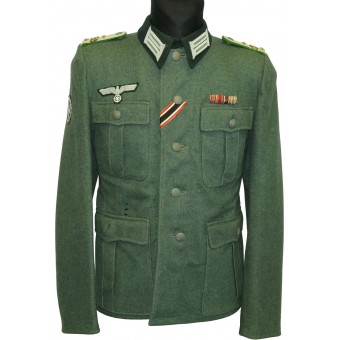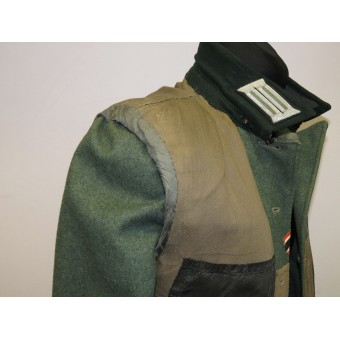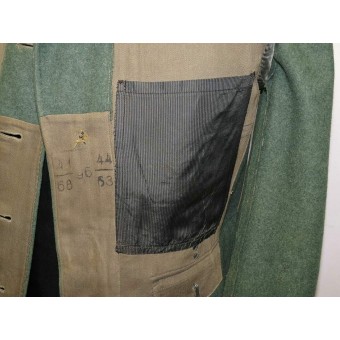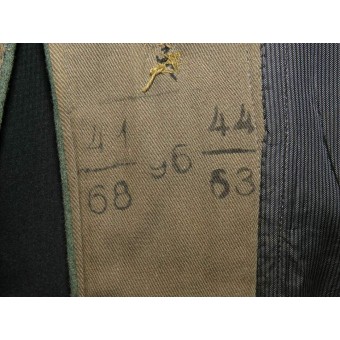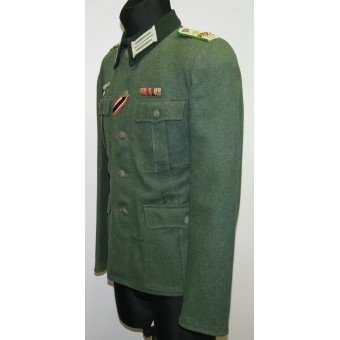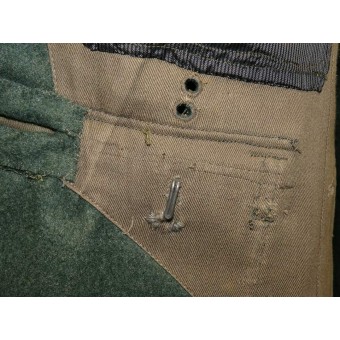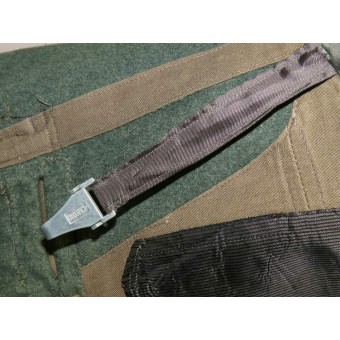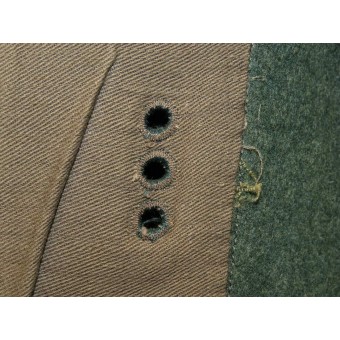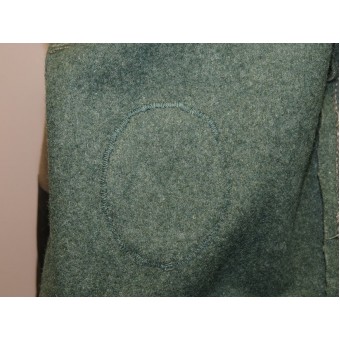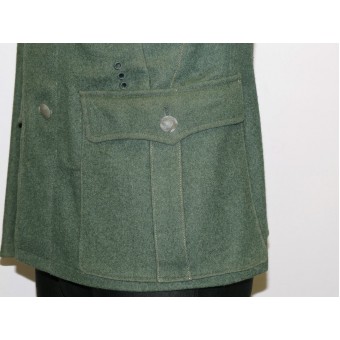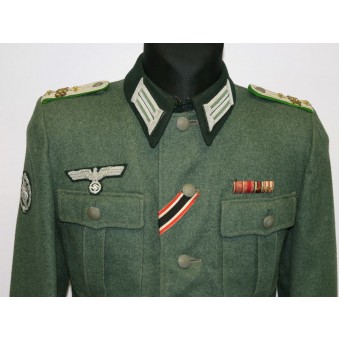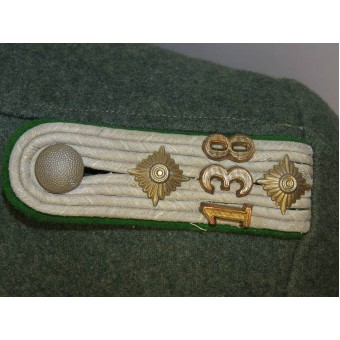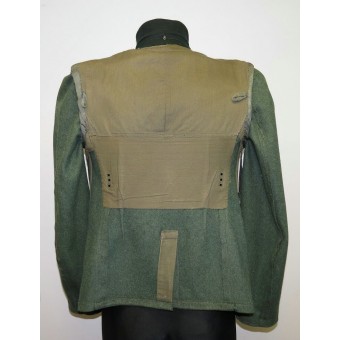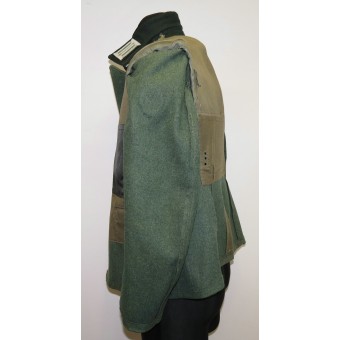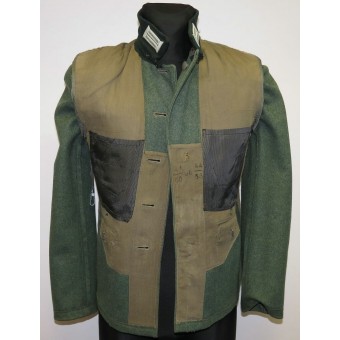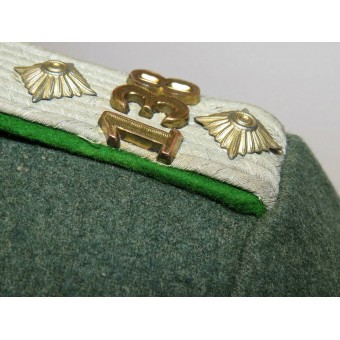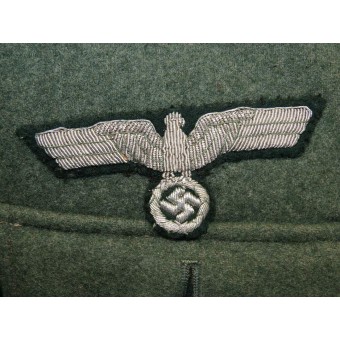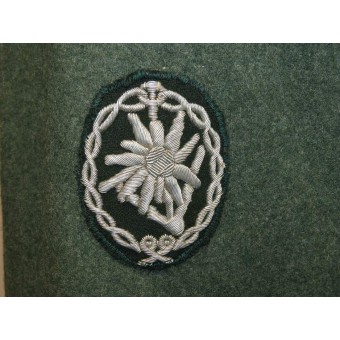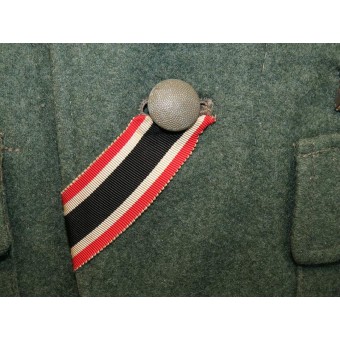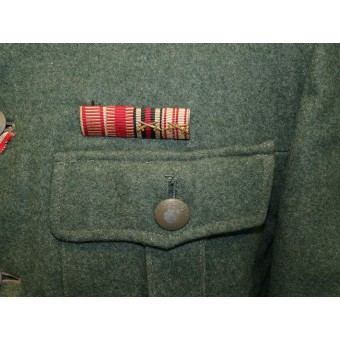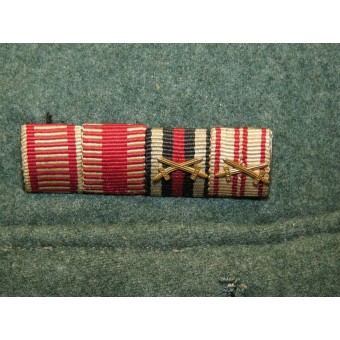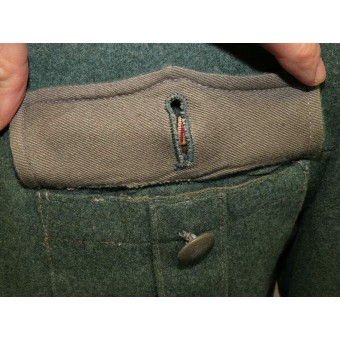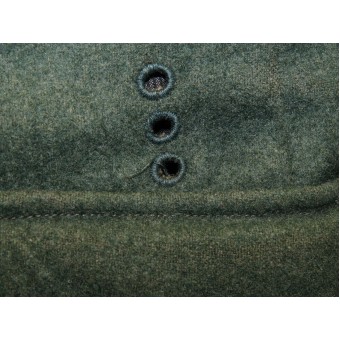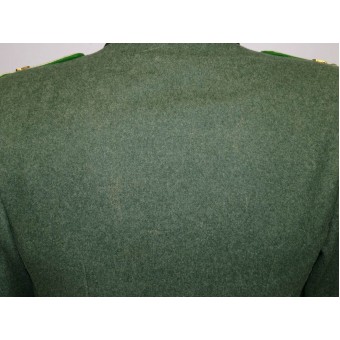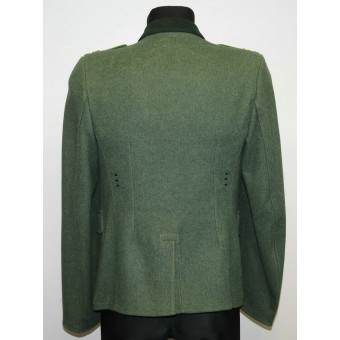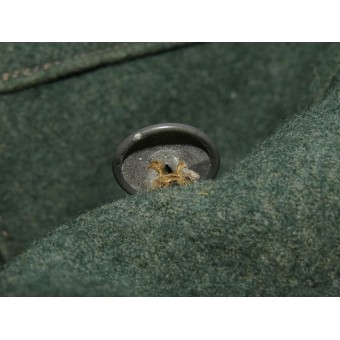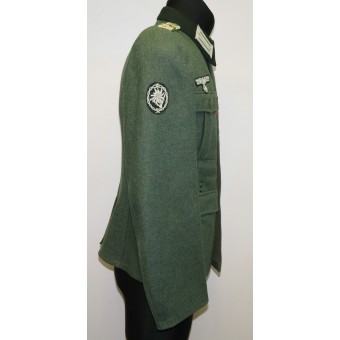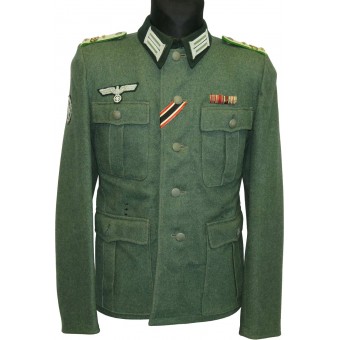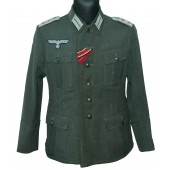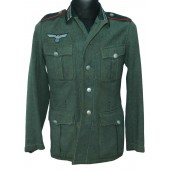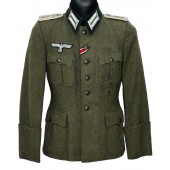M36 Feldbluse-tunika muunnettu/uudelleen räätälöity taisteluupseeria varten Gebirgsjager-rykmentti 138:lle.
Tämä on automaattinen käännös. Katso alkuperäinen englanninkielinen teksti napsauttamalla tätä >>
The regiment has been fought in Polish campaign, as well Norway and Eismeerfront in northern Russia in Murmansk and hard combat in Liza area, where they lost 1/3 of the Regiment. October 1941, the regiment has been sent to the rear to the Baltic sea for reinforcement. In August of 1942 sent back to the Eastern front for reinforcement of 11th army, and take part in hard combat in Wolchow front from Mga by Leningrad to the Pskov area to protect closing the pocket in the area of Novo-Sokolniki. The regiment successfully done the order, but lost 624 KIA, 70 MIA and 1792 wounded. The regiment has been then sent for the rest to Belorussia in the area of Mogilev. In March 1943, the Regiment has been sent to reinforce the 3rd Mountain Division, which is located in the Voroshilovsk area ( now Alchevsk- Lugansk republic, Ukraine). On the 28th of March, 1943, the division was fully completed as it has been newer full after beginning of the war. On July 17, 1943, parts of the regiment were deployed in the section of the 304th Infantry Division to clean up a Soviet breakthrough in the space between Malo Nikolaevka and Shterovka. The battle raged until July 22, 1943. At the end of August 1943 the Soviet offensive began. The regiment was pushed farther and farther westward by the force of the Soviet attacks. On September 9, 1943, the so-called "lizard position" was reached. On September 13, 1943, Antonovka - Zelenopolje- Vodnaya was reached, on September 14, 1943, the west bank of the Gaitschul, and on 16 September, the western bank of Konka. September 20, 1943, the prepared "Wotan" position was taken. Until September 26, 1943, the regiment had a little peace here. Then the Soviet offensive broke loose again. And this time the regiment succeeded in defending the positions. On 9 October 1943 Soviets attacks began again. And this time the front was moving again. Until November 14, 1943, the regiment was pushed back into the bridgehead of Nikopol. But there was no time to rest here either. 20 November 1943 the Red Army also attacked this new frontline. But to the end of November 1943 the frontline has been kept. In early December, the mud period and the weather change ended the enemy offense. At the beginning of February, the Red Army had succeeded in breaking into the Nikopol bridgehead. The 3rd Mountain Division was then withdrawn to the west. But the Red Army was quicker, and the 3rd Mountain Division was encircled. Before the February 12, 1944, when they breaked out the breach near Krasniy and open the gate to Nikolaev. Here the regiment was used to defend the Ingulyetc. These defensive battles lasted until March 13, 1944. On 7 March 1944 the retreat to Novo Sergeyevka commenced. The 3rd Mountain Division was surpassed by enemy units and could break through to the bow until 18 March 1944. There, the division was deployed in the area from Chitchekleja to Dimitrijewka. On March 29, 1944, the company "Alphabet" started off to the Dniester, which meant a march of 300 km within 12 days. But the regiment had heavy losses and actually existed as a Kampfgruppe. Until June 8, 1944, the regiment was pushed back to the Moldovia. In August 1944, the Red Army pushed forward. On 25 August 1944 Draceni was taken to the pocket . The regiment was used to protect the Bistritz Valley. On September 7, 1944, Bistricioara had to be given up, until the end of October 1944 the Tisza was reached via the Aurel Pass. In the last year of the war, the regiment was in defensive action in the High Tatras, near Jablunkau and Freistadt, later the remains of the 138's passed over Olsa, Neutitschin to the area south of Olomouc, there the war for the 138 GJR had ended. In May 1945 the Ostmark's hunters laid down their arms and get back their families
Tämä on automaattinen käännös. Katso alkuperäinen englanninkielinen teksti napsauttamalla tätä >>
The regiment has been fought in Polish campaign, as well Norway and Eismeerfront in northern Russia in Murmansk and hard combat in Liza area, where they lost 1/3 of the Regiment. October 1941, the regiment has been sent to the rear to the Baltic sea for reinforcement. In August of 1942 sent back to the Eastern front for reinforcement of 11th army, and take part in hard combat in Wolchow front from Mga by Leningrad to the Pskov area to protect closing the pocket in the area of Novo-Sokolniki. The regiment successfully done the order, but lost 624 KIA, 70 MIA and 1792 wounded. The regiment has been then sent for the rest to Belorussia in the area of Mogilev. In March 1943, the Regiment has been sent to reinforce the 3rd Mountain Division, which is located in the Voroshilovsk area ( now Alchevsk- Lugansk republic, Ukraine). On the 28th of March, 1943, the division was fully completed as it has been newer full after beginning of the war. On July 17, 1943, parts of the regiment were deployed in the section of the 304th Infantry Division to clean up a Soviet breakthrough in the space between Malo Nikolaevka and Shterovka. The battle raged until July 22, 1943. At the end of August 1943 the Soviet offensive began. The regiment was pushed farther and farther westward by the force of the Soviet attacks. On September 9, 1943, the so-called "lizard position" was reached. On September 13, 1943, Antonovka - Zelenopolje- Vodnaya was reached, on September 14, 1943, the west bank of the Gaitschul, and on 16 September, the western bank of Konka. September 20, 1943, the prepared "Wotan" position was taken. Until September 26, 1943, the regiment had a little peace here. Then the Soviet offensive broke loose again. And this time the regiment succeeded in defending the positions. On 9 October 1943 Soviets attacks began again. And this time the front was moving again. Until November 14, 1943, the regiment was pushed back into the bridgehead of Nikopol. But there was no time to rest here either. 20 November 1943 the Red Army also attacked this new frontline. But to the end of November 1943 the frontline has been kept. In early December, the mud period and the weather change ended the enemy offense. At the beginning of February, the Red Army had succeeded in breaking into the Nikopol bridgehead. The 3rd Mountain Division was then withdrawn to the west. But the Red Army was quicker, and the 3rd Mountain Division was encircled. Before the February 12, 1944, when they breaked out the breach near Krasniy and open the gate to Nikolaev. Here the regiment was used to defend the Ingulyetc. These defensive battles lasted until March 13, 1944. On 7 March 1944 the retreat to Novo Sergeyevka commenced. The 3rd Mountain Division was surpassed by enemy units and could break through to the bow until 18 March 1944. There, the division was deployed in the area from Chitchekleja to Dimitrijewka. On March 29, 1944, the company "Alphabet" started off to the Dniester, which meant a march of 300 km within 12 days. But the regiment had heavy losses and actually existed as a Kampfgruppe. Until June 8, 1944, the regiment was pushed back to the Moldovia. In August 1944, the Red Army pushed forward. On 25 August 1944 Draceni was taken to the pocket . The regiment was used to protect the Bistritz Valley. On September 7, 1944, Bistricioara had to be given up, until the end of October 1944 the Tisza was reached via the Aurel Pass. In the last year of the war, the regiment was in defensive action in the High Tatras, near Jablunkau and Freistadt, later the remains of the 138's passed over Olsa, Neutitschin to the area south of Olomouc, there the war for the 138 GJR had ended. In May 1945 the Ostmark's hunters laid down their arms and get back their families


